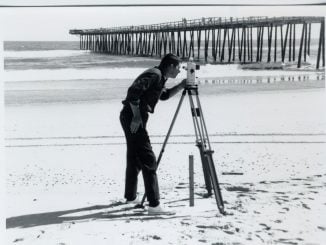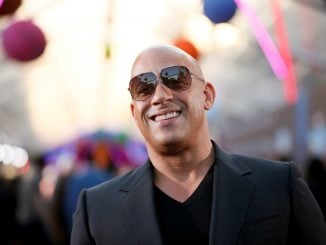
Oct. 2, 1961
The Battleship North Carolina arrives in Wilmington
The Battleship North Carolina came to Wilmington on this day in 1961. The mighty ship opened to the public just a couple of weeks later. At the time of her commissioning on April 9, 1941, she was considered the world’s greatest sea weapon. During World War II, North Carolina participated in every major naval offensive in the Pacific area of operations and earned 15 battle stars. The battleship survived many close calls and near misses with one hit when a Japanese torpedo slammed into the battleship’s hull on Sept. 15, 1942. A quick response on the part of the crew allowed the mighty ship to keep up with the fleet. By war’s end, the battleship lost only 10 men in action and had 67 wounded. After serving as a training vessel for midshipmen, North Carolina was decommissioned in 1947. In 1958 the announcement of her impending scrapping led to a statewide campaign by citizens of North Carolina to save the ship and bring her back to namesake state. The campaign included a special effort among North Carolina’s school children, and of the 1.1 million children in school at the time, 700,000 gave at least a dime. The battleship remains there today, standing sentinel in the Cape Fear River, one of 27 State Historic Sites.
Oct. 2, 1894
State School for the Deaf opened in Morganton
The North Carolina School for the Deaf opened with 104 students and eight teachers. The first superintendent was Edward McKee Goodwin, who served in that position until his death in 1937. A state-supported school for the deaf and blind was first proposed in 1816, but no provision was made for such an institution until the 1840s when Gov. John Motley Morehead took up the cause. In 1844, the legislature appropriated $5,000 for the school and, the following year, the Governor Morehead School was established in Raleigh to teach the deaf, dumb and blind. By 1890, a movement was afoot to create a separate school for the deaf to alleviate overcrowding at the Raleigh campus. Morganton civic leaders organized by Samuel McDowell Tate sought the new school, offering the state $5,000 and 100 acres on “Spa Hill,” a picturesque hilltop setting on the outskirts of town. Construction began in 1891. The monumental Main Building was the first to be erected and still dominates the campus today. Today, the North Carolina School for the Deaf campus in Morganton has 19 buildings and students in kindergarten through 12th grade. An eastern campus opened in Wilson in 1964.
Oct. 3, 1900
Famed writer Thomas Wolfe is born in Asheville
Famed writer from Asheville Thomas Wolfe was born in 1900. Wolfe attended public schools in Asheville for seven years while living in his mother’s boardinghouse with the rest of his family. Growing up in Asheville formed the basis for his thinly-veiled autobiographical novel “Look Homeward, Angel,” which was published in 1929. Asheville residents easily recognized themselves in the text, and Wolfe received letters from irate readers who felt wrongly portrayed in the book. It was 1937 before he would return to his childhood home, having published many short stories and a second novel, “Of Time and the River,” in the meantime. Although he planned to spend the summer writing in a rented cabin, Wolfe worked little, being constantly disturbed by visitors and undergoing family strife. He began to ponder the many implications of the phrase “You can’t go home again,” the title of a novel that would be published in 1940, two years after his death. His mother’s former boardinghouse known as the “Old Kentucky Home,” made famous as “Dixieland” in his first novel, is now a State Historic Site.
Oct. 5, 1909
East Carolina set up to educate teachers
On this day in 1909, the East Carolina Teachers Training School opened its doors with the mission of providing young men and women the training they needed to be able to teach in the public schools of North Carolina. The school was established in Greenville in 1907 at the urgent persuasion of former governor and Greenville resident Thomas Jordan Jarvis. There were seven other eastern North Carolina communities vying for the institution including Edenton, Washington, Kinston, New Bern, Tarboro, Rocky Mount and Elizabeth City. When the school opened in October 1909, there were 11 faculty members to teach the 104 women and 19 men enrolled in a two-year training program. In 1911, 16 members of the first class graduated, all of them women. The first man to graduate, Henry Oglesby, did not do so until 1932. In 1921, the school began offering four-year degrees. The college offered its first master’s degree in 1929 and began to diversify its curriculum. The school was renamed East Carolina University in 1967, and was incorporated into the UNC system five years later. Today, East Carolina University is the third largest school in the UNC system, with an outstanding reputation in the fields of teacher training, music, art and medicine.
Oct. 6, 1967
Duke graduates nation’s first physician assistants
Three students graduated from Duke’s Physician Assistant (PA) Program and became the first PAs in the country. When Dr. Eugene A. Stead Jr., then chairman of Duke’s Department of Medicine, established the PA program in 1965, it was the first of its kind in the nation. A two-year course that trained students to practice medicine and provide health care services under a doctor’s supervision, the program aimed to address the problem of the physician shortage, particularly in rural areas throughout North Carolina. While the initial recruitment was targeted at ex-military corpsmen who possessed some medical experience, Duke’s PA program soon attracted a wide range of applicants, including women and people of color seeking new career opportunities in medicine. Today there are nearly 100,000 PAs practicing across the United States. The success of the profession during the second half of the 20th century is due in part to the early efforts of PA leaders, graduates and students in North Carolina. They worked to have the profession legally recognized and accredited, founded the American Academy of Physician Assistants — the official organization for the profession — and were instrumental in the development of certification and continuing education guidelines.



